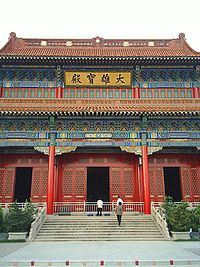Views
Gāomín sì 高旻寺
|
|
|
|
Gāomín sì 高旻寺 was one of the most important Chán 禪 training centers in China in the 20th century. It has recently been rebuilt on a massive scale.
Contents |
History
This temple was first built in the Suí Dynasty. One of its central features, the Tiānzhōng Pagoda 天中塔, was constructed in 1651 (Shùnzhì 順治 8). It was named Gāomín Temple 高旻寺 by Emperor Kāngxī 康熙 in 1703 (Kāngxī 康熙 42).
By the late 19th century, this temple already had a reputation for the strength of its Chán 禪 training. Many monks who later became prominent in Chinese Buddhism studied here under Abbot Yuèláng 月郎. In 1915, the abbotship passed to Láiguǒ 來果. In his 35-year tenure as abbot, Láiguǒ emphasized a strict observance of the precepts at the monastery, as well as its identity as an explicitly Chán-oriented temple. He also set about rebuilding, renovating, and adding to the temple structures. This latter work was of such scale that it had not been completed by the start of the Second Sin-Japanese War in 1937.
The temple was almost completely leveled during the Cultural Revolution, but in the last decade it has been massively rebuilt.
Personnel
Important Abbots
Notable Residents
- Yuèxiá 月霞 (late 19th century)
- Xūyún 虛雲 experienced an awakening here in 1895 (Guāngxù 光緒 21)
- Yīngcí 應慈 (first decade of the 20th century)
Temple Institution
Important Buildings or Artifacts
- Chán Hall 禪堂
- This is a circular hall and features two concentric chambers, which allows for the accomodation of hundres of extra monks during its well-attended retreat seasons 安居.
Associated Organizations and Groups
Notes
